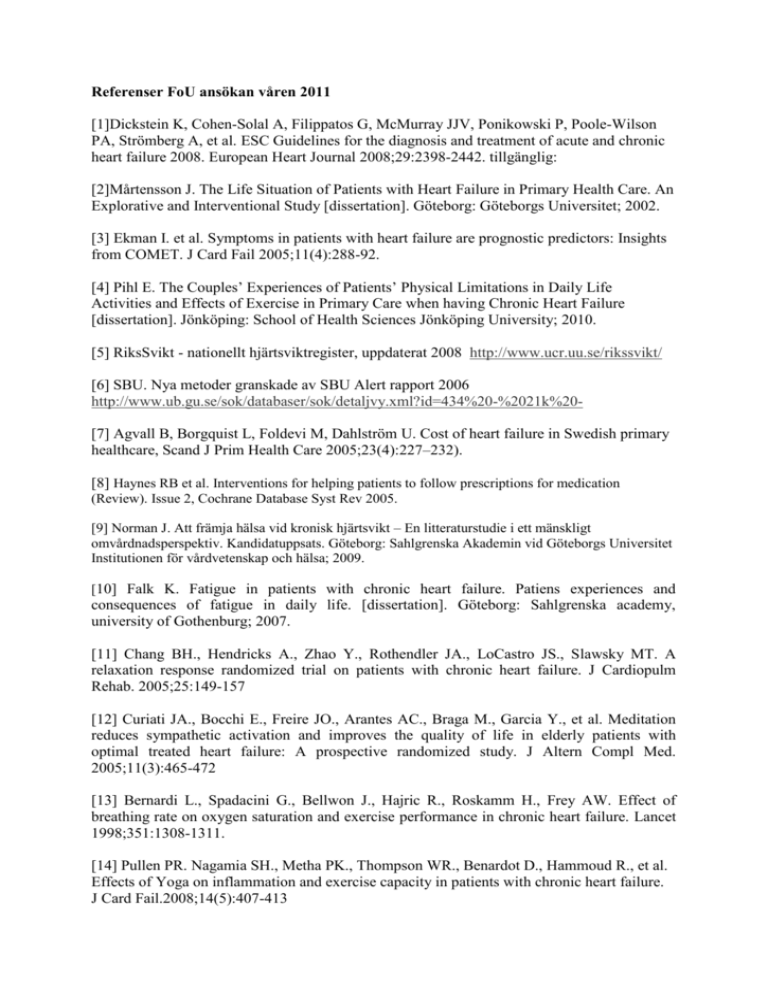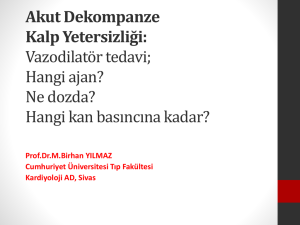Referenser FoU ansökan våren 2011
advertisement

Referenser FoU ansökan våren 2011 [1]Dickstein K, Cohen-Solal A, Filippatos G, McMurray JJV, Ponikowski P, Poole-Wilson PA, Strömberg A, et al. ESC Guidelines for the diagnosis and treatment of acute and chronic heart failure 2008. European Heart Journal 2008;29:2398-2442. tillgänglig: [2]Mårtensson J. The Life Situation of Patients with Heart Failure in Primary Health Care. An Explorative and Interventional Study [dissertation]. Göteborg: Göteborgs Universitet; 2002. [3] Ekman I. et al. Symptoms in patients with heart failure are prognostic predictors: Insights from COMET. J Card Fail 2005;11(4):288-92. [4] Pihl E. The Couples’ Experiences of Patients’ Physical Limitations in Daily Life Activities and Effects of Exercise in Primary Care when having Chronic Heart Failure [dissertation]. Jönköping: School of Health Sciences Jönköping University; 2010. [5] RiksSvikt - nationellt hjärtsviktregister, uppdaterat 2008 http://www.ucr.uu.se/rikssvikt/ [6] SBU. Nya metoder granskade av SBU Alert rapport 2006 http://www.ub.gu.se/sok/databaser/sok/detaljvy.xml?id=434%20-%2021k%20[7] Agvall B, Borgquist L, Foldevi M, Dahlström U. Cost of heart failure in Swedish primary healthcare, Scand J Prim Health Care 2005;23(4):227–232). [8] Haynes RB et al. Interventions for helping patients to follow prescriptions for medication (Review). Issue 2, Cochrane Database Syst Rev 2005. [9] Norman J. Att främja hälsa vid kronisk hjärtsvikt – En litteraturstudie i ett mänskligt omvårdnadsperspektiv. Kandidatuppsats. Göteborg: Sahlgrenska Akademin vid Göteborgs Universitet Institutionen för vårdvetenskap och hälsa; 2009. [10] Falk K. Fatigue in patients with chronic heart failure. Patiens experiences and consequences of fatigue in daily life. [dissertation]. Göteborg: Sahlgrenska academy, university of Gothenburg; 2007. [11] Chang BH., Hendricks A., Zhao Y., Rothendler JA., LoCastro JS., Slawsky MT. A relaxation response randomized trial on patients with chronic heart failure. J Cardiopulm Rehab. 2005;25:149-157 [12] Curiati JA., Bocchi E., Freire JO., Arantes AC., Braga M., Garcia Y., et al. Meditation reduces sympathetic activation and improves the quality of life in elderly patients with optimal treated heart failure: A prospective randomized study. J Altern Compl Med. 2005;11(3):465-472 [13] Bernardi L., Spadacini G., Bellwon J., Hajric R., Roskamm H., Frey AW. Effect of breathing rate on oxygen saturation and exercise performance in chronic heart failure. Lancet 1998;351:1308-1311. [14] Pullen PR. Nagamia SH., Metha PK., Thompson WR., Benardot D., Hammoud R., et al. Effects of Yoga on inflammation and exercise capacity in patients with chronic heart failure. J Card Fail.2008;14(5):407-413 [15] Yeh GY., Wood MJ., Lorell BH., Stevenson LW., Eisenberg DM., Wayne PM., et al. Effects of Tai Chi Mind-Body Movement Therapy on functional status and exercise capacity in patients with chronic heart failure: a randomized controlled trial. Am J Med 2004; 117: 541-548. [16] Barrow DE., Bedford A., Ives G., O´Toole L., Channer KS. An evaluation of the effects of Tai Chi Chuan and Chi Kung training in patients with symptomatic heart failure: a randomized controlled pilot study. Postgrad Med J. 2007; 83:717-721. [17] Kabat-Zinn J.,An outpatient program in behavioral medicine for chronic pain patients based on the practice of mindfulness meditation: theoretical considerations and preliminary results. Gen Hosp Psychiatry. 1982;4(1):33-47 [18] Bruckstein D.C. Effects of acceptance based and cognitive behavioural intervention on chronic pain managements. Hempstead, New York: Hofstra University; 1999 [19] Kabat-Zinn J., et al. Effectiveness of a meditation-based stress reduction program in the treatment of anxiety disorders. Am J Psychiatry.1992;149(7):936-43 [20] Kabat-Zinn J., et al. Influence of a mindfulness meditation-based stress reduction intervention on rates of skin clearing in patients with moderate to severe psoriasis undergoing phototherapy (UVB) and photochemotherapy (PUVA). Psychosom Med. 1998;60(5):625-32 [21] Mills N. and Allen J. Mindfulness of movement as a coping strategy in multiple sclerosis: a pilot study. Gen Hosp Psychiatry. 2000;22:425-31 [22] Pradhan E. K., et al. Effects of mindfulness-based stress reduction on psychological and physical symptoms of rheumatoid arthritis. 2006 [23] Plews-Ogan M., et al. A pilot study evaluating mindfulness-based stress reduction and massage for the management of chronic pain. J Gen Intern Med. 2005;20(12):1136-8 [24] Weissbecker I., et al. Mindfulness-based stress reduction and sence of coherence among women with fibromyalgia. J Clin Psycholog Med. 2002;9(4):297-307 [25] Tacon A. M., et al. Mindfulness meditation, anxiety reduction and heart disease: a pilot study. Fam Community Health. 2003;26(1):25-33 [26] Roberts McComb J.J., et al. A pilot study to examine the effects of a mindfulness-based stress reduction and relaxation program on levels of stress hormones, physical functioning, and submaximal exercise response. J Altern Complement Med. 2004;10(5):819-27 [27] Speca M., et al. A randomized, wait-list controlled clinical trial: the effects of a mindfulness meditation-based stress reduction program on mood and symptoms of stress in cancer outpatients. Psychosom Med. 2000;62(5):613-22 [28] Folkman S. The case for positive emotions in the stress process. Anxiety Stress Coping. 2008 Jan;21(1):3-14 Review [29] Lutz A., et al. Longterm meditators self-induce high-amplitude gamma synchrony during practice. Proc Natl Acad Sci USA. 2004;101:16369-73 [30] Lazar S.W., et al. Meditation experience is associated with increased cortical thickness. Neuroreport 2005;16(17):1893-97 [31] Davidson R.J., et al. Alteration in Brain and Immune Function Produced by Mindfulness Meditation. Psychosomatic Medicine. 2003;65:564-70 [32] Baer R.A. Mindfulness Training as a clinical Intervention: A Conceptual and Emperical Review. Clinical Psychology: Science & Practice. 2003;10(2):125-1433 [33].Ricoeur P. (1966). Freedom and nature: The Volontary and the involuntary. Translated with an introduction by E.V. Kohák. (Originally published in French under the title Le Volontaire et l’involontaire, 1950.) Evanston: Northwestern University Press. [34] Watson J. En teori för omvårdnad. Omvårdnad och humanvetenskap (Original titel: Nursing: Human Science and Human Care. A Theory of Nursing. Översättare till den svenska upplagan: Michael G.Thomas). Lund: Studentlitteratur; 1993. [35] Watson J. The Watson Caring Science Institute. 2010. Tillgänglig: http://www.watsoncaringscience.org/ [36]Watson J. Jean Watson: Theory of human caring. In ME. Parker (Ed.) Nursing theories and nursing practise (pp. 343-354). Piladelphia: F A.Davis. 2001. [37]Benett J. A., Riegel B., Bittner V., Nichols J. Validity and reliabality of the NYHA classes formeasuring research outcomes in patients with cardiac disease. Heart & Lung: The Journal of Acute and Critical Care 2002;31:262-70. [38]Kabat-Zinn J. Full catastrophe living: using the wisdom of your body and mind to face stress, pain and illness. New York; Dell publishing 1990. [39]Schenström O. Mindfulness i vardagen – vägar till medveten närvaro. Första utgåvan, tionde tryckningen. Falun: Viva; 2007 [40]Schenström O. Här&Nu - Ett program för medveten närvaro. Falun: SOL Schenström & Lindqvist; 2009 www.minfulnesscenter.se [41]Kabat-Zinn J. Vart du än går är du där – medveten närvaro i vardagen. Första utgåvan, femte tryckningen. Stockholm: Natur och Kultur; 2008 [42]Ekman I, Olofsson M. Swedberg K, Boman K. Gender make a difference in the description of dyspnea in primary helth care parientes with a confirmed heart failure diagnosis. European Journal of Cardiovascular Nursing 2004. [43]Patel H. et al. Psychmetric properties of a Swedish version of the Kansas City Cardiomyopathy Qustionaire in a Chronic Heart Failure population.Eur J Card Nurs 2008;7:214-21. [44]Dupuy H.J., The Psychological General Well-Being (PGWB) Index, in Assessment of Quality Life in Clinical Trials of Cardiovascular Therapies, N.K. Wenger et. al. Editors. 1984 Le Jacq Puplishing:New York.170-83 [45]Antonovsky A. The structure and properties of the sense of coherence scale. Soc Sci Med, 1993;36(6):725-33. [46]Antonowsky A. Hälsans mysterium. 1999, Köping: Natur och Kultur. [47]Zigmond AS. Snaith RP. The Hospital and Depresson Scale. Acta Psych. Scand 1983; 67:361-370 [48] Bjelland I, Dahl AA, Haug TT et al. The validity of the Hospital Anxiety and Depression Scale. An updated literature review. J Psychosom Res 2002; 52(2):69-77. [49] Krupp LB, LaRocca NG, Muir-Nash J, Steinberg AD. The fatigue severity scale. Application to patients with multiplesclerosis and systemic lupus erythematosus. Arch Neurol 1989;46:1121-3. [50] Baer, R.A. et al. Using self-report assessment methods to explore facets of mindfulness. Assessment 2006;13(1): 27-45. [51]Kecklund G. Akerstedt T. The psychometric properties of the Karolinska Sleep Questionnaire. J Sleep Res 1992;6:221-229. [52]Scott C. Berättelsens praktik och teori – narrativ forskning i ett hermeneutiskt perspektiv. Malmö: Studentlitteratur; 2008. [53] Krippendorf K. Content analysis. An introduction to its methodology. 6th ed. London: Sage; 2004. [54]Kvale S. Den kvalitativa forskningsintervjun. Lund: Studentlitteratur; 1997. [55] Sandelowski M. Focus on research methods. Whatever happened to qualitative description? Research in Nursing & Health 2000;23:334-40. [56] Granheim U.H. & Lundman B. Qualitative content analysis in nursing research: concepts, procedures and measures achive trustworthiness. Nurse Education today 2004;24(2)105-12. [57] Granskär M. & Höglund B. Tillämpad kvalitativ forskning inom hälso- och sjukvård. Polen: Studentliteratur; 2008. [58] Haggerty L. What is…content analysis? Medical Teacher 1996;18(2)99-101.
